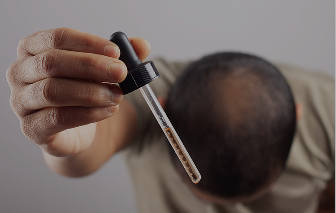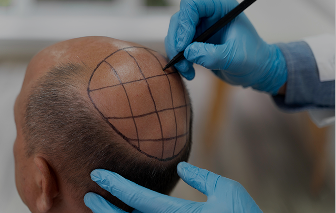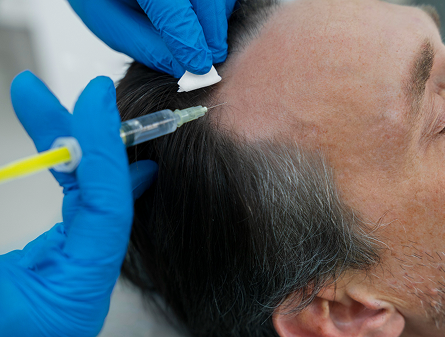Minoxidil is a hair loss treatment that acts as a vasodilator. This means that it increases the blood circulation to the scalp to dilate the blood vessels and allow hair follicles to grow larger, leading to thicker and healthier hair growth.
A hair transplant is a surgical procedure where healthy hair is extracted from a donor site and then implanted into areas that are balding or thinning. This allows for healthy hair growth in places where hair follicles had previously stopped producing hair.
Minoxidil is a topical treatment that needs to be applied up to twice a day to see results. A hair transplant is typically a once-off procedure that can provide long-lasting results. Explore the comparison table below to see the differences between minoxidil and hair transplantation.
- Minoxidil is a topical treatment used to slow or reverse early-stage hair loss.
- Unlike a hair transplant, minoxidil does not add new hair but preserves and stimulates existing follicles.
- A hair transplant involves surgically relocating hair from a donor area to bald spots.
- Unlike minoxidil, it offers a permanent solution to advanced hair loss but is invasive and costly.
- Minoxidil is relatively low-cost in Australia, typically between $20–$50 monthly.
- Unlike hair transplants, minoxidil’s affordability is offset by ongoing monthly expenses over the years of use.
- Hair transplants cost significantly more upfront, ranging from $5,000 to $15,000 per session.
- While expensive compared to minoxidil, it’s a one-time investment with long-term results.
- Minoxidil must be applied daily and used indefinitely to retain regrowth.
- As opposed to a hair transplant, this is a lifetime of adherence and continuous compliance.
- Hair transplants typically take one or two sessions to accomplish and 9–12 months to have the full effect.
- Unlike minoxidil, maintenance is minimal after the procedure is finished.
- The scalp absorbs Minoxidil to enhance blood flow and extend the cycle of hair growth.
- Unlike a transplant, it doesn’t move follicles but rather seeks to stimulate what is left.
- Hair transplants transfer individual follicles to balding areas using FUE or FUT.
- In comparison to minoxidil, the process is surgical and needs post-operative treatment.
- Minoxidil is safe in the majority of users but may produce irritation, redness, or skin flaking.
- Compared to hair transplantation, the risks are minimal and non-surgical.
- Hair transplant procedures carry the risk of infection, scarring, and swelling.
- Unlike minoxidil, they need downtime and recovery.
- Minoxidil is easy to use but must be applied daily and incorporated into a strict routine.
- More effort is needed over time compared to the single-event nature of transplants.
- Hair transplants are a one-time treatment with minimal upkeep.
- Unlike minoxidil, no daily application is needed once the grafts take hold.
- Minoxidil is easily available over the counter in Australia.
- Less restricted in access and easier to start than hair transplants.
- Hair transplants are accessible only from licensed surgeons and require consultations.
- Compared to minoxidil, the treatment is more time-consuming and geographically limited.
- Minoxidil requires continuous use to sustain regrowth; stopping treatment causes reversal within months.
- Results are not permanent like a transplant.
- Hair transplants offer permanent regrowth in treated areas.
- Unlike minoxidil, they don’t rely on continual daily use.
- Minoxidil can be used before or after hair transplants to improve density.
- Works well as part of a maintenance routine post-surgery
- Hair transplants are often complemented by minoxidil or finasteride.
- Compared to minoxidil, transplants act as a foundation rather than a daily intervention.
- Minoxidil appeals to users looking for a low-cost, non-invasive approach to hair regrowth.
- Some users may feel frustrated by the lack of permanence compared to a transplant.
- Hair transplants appeal to those wanting dramatic and lasting results.
- Unlike minoxidil, they offer visible change and a one-time solution for many users.
- Minoxidil improves blood circulation and stimulates follicles but offers no structural hair restoration.
- Less holistic than a transplant in terms of hair density outcomes.
- Hair transplants restore hair volume in bald areas, providing full coverage where minoxidil cannot.
- Unlike minoxidil, they address both cosmetic and density concerns.
- Minoxidil’s regular bottles and packaging create cumulative waste.
- Less sustainable over time than a one-time procedure.
- Hair transplants produce minimal environmental waste post-surgery.
- Compared to minoxidil, they generate less long-term packaging waste.
Shop our hair solutions
We are committed to providing affordable hair regeneration services for people all over Australia. Our formula can help you regain your confidence.
Shop Now

Minoxidil vs Hair Transplant Treatment Options Comparison Summary
Minoxidil is a highly effective treatment for hair loss that has been approved by medical boards such as the FDA. It can work well as a short-term or long-term solution to hair loss but requires consistent use or else the results can be lost. A hair transplant can cover balding areas with new hair growth and act as a long-term option for tackling hair loss.
While not a permanent solution, a hair transplant can provide long-lasting results. The hair around the transplant site can still fall out if hair loss perseveres. Minoxidil is a cheaper solution up front as it can be acquired over the counter or as a prescription from a doctor online or in a clinic.
The medication needs to be consistently applied however to avoid losing the hair growth. A hair transplant can be a significant up-front investment but can be worthwhile in the long run as the transplanted hairs will continue to grow like the rest of your hair and age naturally alongside you.
User Guidance
Minoxidil can provide a more non-invasive treatment option if you are looking to incorporate a topical or oral solution into your daily routine. A hair transplant may suit you better if you are looking for a one-off treatment, if your hair loss has stabilised.
Minoxidil has some potential side effects like itching, tingling and a rash at the application site. A hair transplant carries more risks with it but it can depend on the surgeon and clinic that you opt for.
Minoxidil is widely available as a treatment with many formulations available on the market that have different combinations of ingredients to tailor to your hair loss. A hair transplant is a specialised surgical treatment, meaning you may have to travel to access it.
Take Our Hair Loss Quiz to See Which Treatment Suits You?
Take A Hair Quiz

Frequently Asked Questions
We have put some commonly asked questions.
Nunc scelerisque tincidunt elit. Vestibulum non mi ipsum. Cras pretium suscipit tellus sit amet aliquet. Vestibulum maximus lacinia massa nontor.
Platelet-rich plasma (PRP) treatment involves drawing blood from the patient, isolating the beneficial nutrients and injecting it into the scalp where hair loss is occurring. This promotes hair growth and has many other applications from encouraging healing to skin rejuvenation.
Platelet-rich plasma (PRP) treatment involves drawing blood from the patient, isolating the beneficial nutrients and injecting it into the scalp where hair loss is occurring. This promotes hair growth and has many other applications from encouraging healing to skin rejuvenation.
Platelet-rich plasma (PRP) treatment involves drawing blood from the patient, isolating the beneficial nutrients and injecting it into the scalp where hair loss is occurring. This promotes hair growth and has many other applications from encouraging healing to skin rejuvenation.







 See All
See All